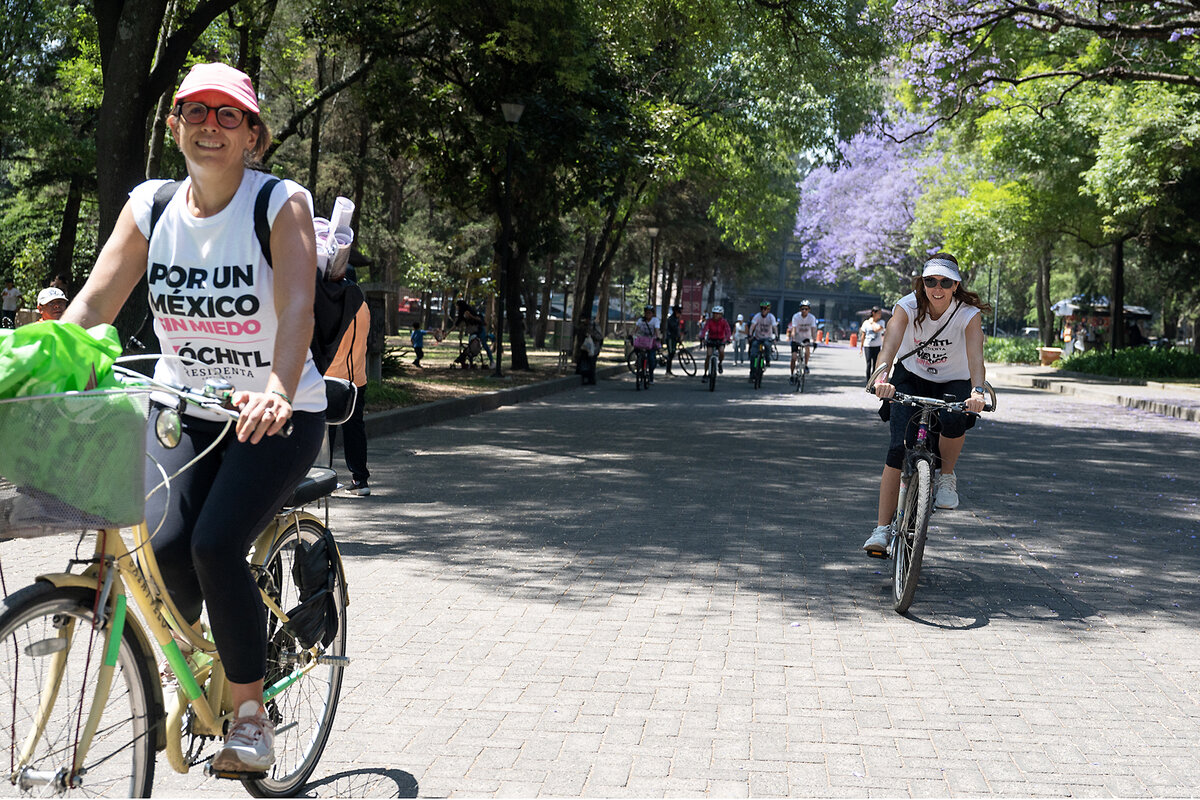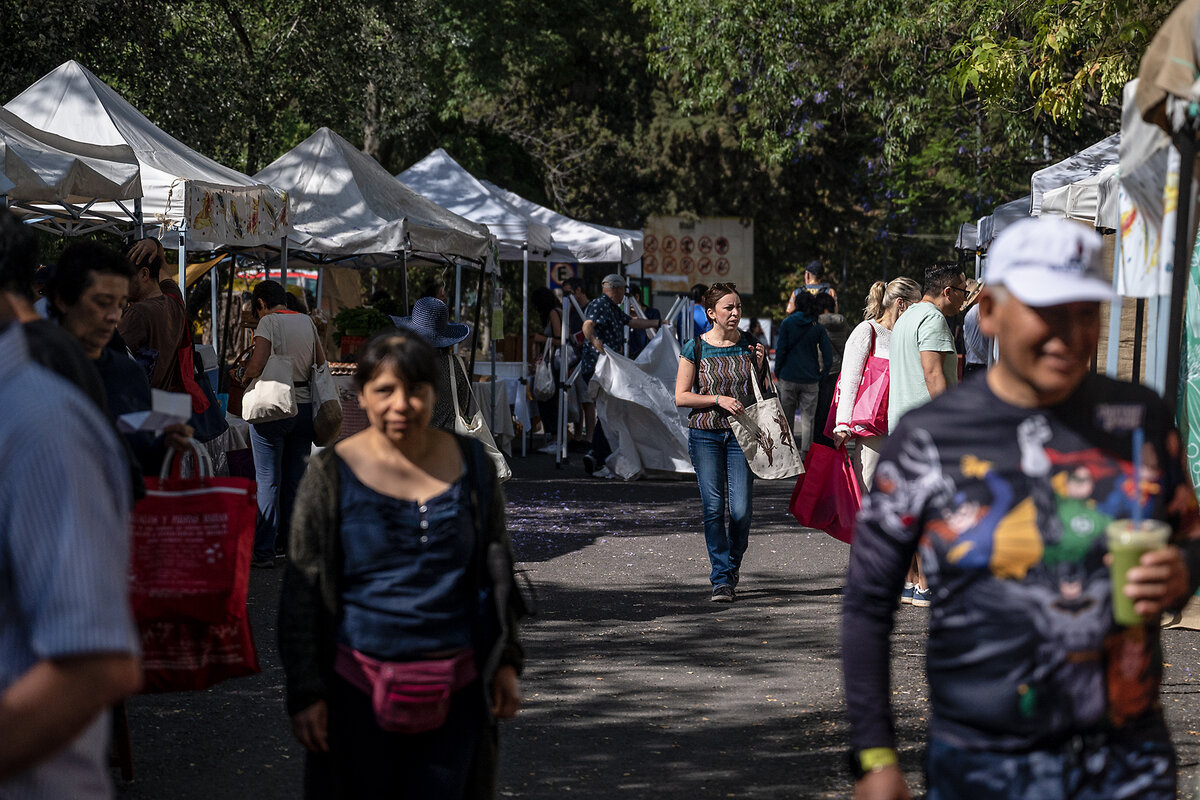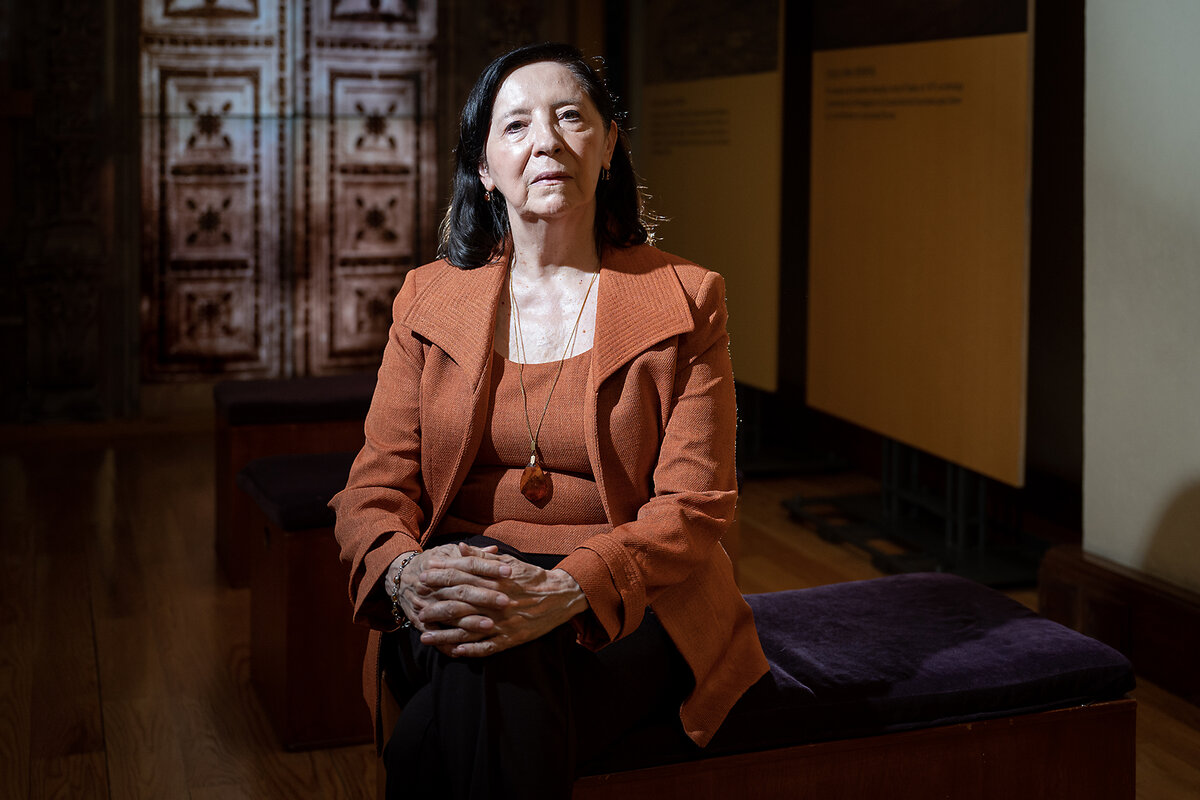Mexico is poised to elect its first woman president. Will women’s lives improve?
Loading...
| Mexico City
When Brenda Magaña Díaz was growing up in a working-class Mexico City neighborhood in the early 2000s, no one ever told her a woman could one day become president.
She had few obvious role models when she became one of six women in her graduating law school class. When she went on to work as a staffer at the Supreme Court and later for the president of the Mexican Congress, most of her colleagues were male.
On a recent day, Ms. Magaña, who now coordinates the “war room” of a candidate in Mexico’s upcoming presidential election, moves fast despite her stiletto heels, greeting a receptionist warmly as she heads upstairs and through a bright open room. A dozen young men and women are clicking away on their computers.
Why We Wrote This
A story focused onMexican women have long struggled with their country’s culture of machismo. Now Mexico, ahead of the United States, is about to elect its first woman as president.
Her path to this point in her career may have been a lonely one – but it won’t be for girls growing up in 2024.
Julia Álvarez Icaza Ramírez came of age during the same era as Ms. Magaña, but in a middle-class Mexico City neighborhood. She didn’t have adults impressing upon her the possibility that a woman could be president, either. Growing up within Mexico’s burgeoning feminist movement, however, the young lawyer has focused her career on arguing for better gender perspectives in her country’s sentencing practices, a part of her wider commitment to restorative justice. Now Ms. Álvarez is putting that lens on the office of the president.
On another recent day, Ms. Álvarez is sitting in a spacious sound booth as part of a radio debate. In a circle of business suits and collared shirts, she wears an embroidered huipil, a traditional garment worn by Indigenous women, over her bluejeans. Amid tie clips and watches, she wears a delicate silver hoop glinting in her right nostril as she pleads her case for the leftist candidate she supports.
These two women hail from different ideological folds, but they are united in one effort: to see this macho country elect its first woman as president when it heads to the polls June 2.
Ms. Álvarez is a spokesperson for Claudia Sheinbaum Pardo, the former mayor of Mexico City and hand-picked successor of outgoing populist President Andrés Manuel López Obrador. Dr. Sheinbaum, who has a Ph.D. in energy engineering, is favored to win, polling at roughly 59%.
Ms. Magaña is the technical and war room coordinator for former Sen. Xóchitl Gálvez Ruiz, the candidate who represents a coalition of three conservative opposition parties, each with long histories in Mexico. Ms. Gálvez is polling at 35%. These numbers all but guarantee that Mexico’s next president will be a woman.
It’s a stunning expression of women’s growing clout in Mexican politics. But if the current contest is a visible example of that nascent political power, the foundations have been laid by women like Ms. Magaña and Ms. Álvarez and those before them. Like all those who fought, often invisibly, to get Mexico to this point, each woman continues to push against stubborn stereotypes and inequities.
“If I grew up believing power was only exercised by men, imagine a young girl who grows up during a woman’s presidency,” says Ms. Magaña. “Generations will start to see the world, possibilities, differently.”
Ms. Álvarez has been waiting her whole life for this.
“I was born ready for a woman president,” she says.
The road to parity
Mexico is known internationally for its machismo, a cultural emphasis put on stereotypical manliness and control. It permeates all parts of society. Violence and the number of women murdered with impunity continue to dominate the news – as well as perceptions of the country.
The National Autonomous University of Mexico is the first institution of higher education in North America, founded in 1551. But women weren’t granted access for another 300 years, a half-century after American women began to be accepted into colleges. Women gained the right to vote in 1953, three decades after U.S. women.
Mexican women’s historical exclusion from education, daily life, and politics traces back to the country’s long relationship with the conservative Catholic Church. For centuries the church dictated how and where women could move in public. During the Mexican Revolution, from 1910 to 1917, women bore arms and organized to end dictatorship and gain independence from the church. But they were denied suffrage afterward.
“It was argued that if they gave women the right to vote, they would undermine the revolution,” says Patricia Galeana, a historian of gender in Mexico and former ambassador to Colombia.
With the arrival of one-party rule in 1929, Mexican politics and culture were dominated by the Institutional Revolutionary Party (PRI) over the next seven decades. “In a single-minded culture, change is more difficult,” says Dr. Galeana.
Toward the end of the PRI’s grip on democracy in 2000 came not just a political but also a cultural opening that has buoyed women. Gender quotas were initially recommended in 1993, and by 2019 Mexico adopted a constitutional reform mandating “parity in everything,” including any public office. By 2021, the lower house of Congress was 50% women, and the president’s Cabinet has reached parity, too.
In April this year, Mexico’s legislature was ranked fourth globally in terms of women’s parliamentary representation. The United States is a distant 71st. Some 53% of Mexican men and 69% of Mexican women said they would prefer to have a woman as their next president, according to an Enkoll poll this February. They say they expect a woman to deal with issues like managing the economy and fighting corruption better than a male leader.
The candidates
On a recent weekday morning, Mexico City’s historic Zócalo plaza is flooded with vendors selling political trinkets plastered with the face of President López Obrador, whom people refer to as AMLO. Part of the Morena political party, his government has overseen one of the bloodiest periods in Mexican history, with nearly 30,000 murders annually over the past five years. Yet his approval ratings remain above 60%, and that has bolstered his party’s candidate, Dr. Sheinbaum, whose face appears sprinkled among piles of stuffed AMLO dolls, oven mitts, and keychains.
Dr. Sheinbaum is seen as the continuation of AMLO’s policies and his project to transform the nation. That means she’s expected to continue supporting austerity measures, vast infrastructure projects, and the newly created National Guard. But the climate scientist and granddaughter of Jewish immigrants says she’ll put her own imprint on Morena policies, including lessons in crime reduction she learned as Mexico City mayor from 2018 to last year.
Ms. Gálvez’s image is not nearly as ubiquitous. The candidate of the conservative coalition grew up selling gelatin treats on the street in her home state of Hidalgo and went on to study engineering, becoming a tech entrepreneur. Her father was an Indigenous Otomi schoolteacher, and by her account, physically and emotionally abusive. She entered public office in 2000 to run the Indigenous Peoples’ Development Office under then-President Vicente Fox.
Her platform includes raising taxes on Mexico’s wealthy people, creating a national child care system, opening the state-run oil company to foreign investment, and doubling down on the use of the military to fight organized crime.
Although both candidates found themselves tripping over each other in the first presidential debate in April, agreeing on liberal policies like protecting the human rights of transgender populations, their political affiliations are lightning rods for division, especially along socioeconomic lines.
This polarization has in some ways overshadowed the excitement of the prospect of electing the country’s first female leader. Still, having a woman as president of Mexico will only help to empower women, observers say.
“This is going to be an incredibly important change,” says Dr. Galeana, who warns the stakes are high. “What I hope from the next president is that she isn’t a Juanita,” says Dr. Galeana. A disparaging expression, “a Juanita” refers to a hypothetical woman who would win an election after the country introduced its gender quota requirements. But after winning, she would immediately step down so a man could be appointed to take the office instead.
“I hope that she has the position, but she also has the power,” she says.
Proving themselves
Indeed, both candidates have been dismissed as “puppets” of men. AMLO critics say Dr. Sheinbaum was selected because she proved loyal. The implication is, she’s only in the race because AMLO can control her to do his bidding. (Mexican presidents serve only one term.)
Ms. Gálvez has also been called a “token,” a candidate for a coalition of three deeply entrenched and formerly opposing political parties that are each led by men.
Standing in the shadow of Mexico City’s iconic Angel of Independence monument, Rolando Ortiz Peon dismisses the idea that sexism is behind all the national chatter that the candidates only stand in the shadow of men. Wearing a campaign T-shirt that reads, “Xóchitl for President: For a Mexico without fear,” he says, “The fact that people are pointing to Claudia or pointing to Xóchitl and calling them puppets is more about political polarization than machismo.”
His wife, Maria Estella Sánchez Rojas, interjects. The two have just finished a group bike ride in which participants handed out “Xóchitl” stickers throughout the city. (The candidate Ms. Gálvez often arrives at her events riding a bicycle.) “It is sexist to paint a woman in power as only being there because she’s manipulated by a man,” she tells her husband. One effect of the prevalence of machismo in Mexico, she says, is that “many women buy into the misogyny. They might even worsen it.”
Despite the explosion of political representation among women, this presidential campaign has underscored the work that still must be done. Both candidates have defended their qualifications to run as media tropes and polling questions ask if macho Mexico “is ready” for a woman.
Ms. Gálvez wrapped up a speech last fall about her plans for fighting violence in the country by saying she has “the ovaries” to fight criminals and assuring voters that she’s “not afraid.”
Dr. Sheinbaum has told crowds that Mexico has women engineers, firefighters, and deputies, as if convincing voters of the nation’s preparedness for a woman as president is a necessary part of her platform. AMLO defended her qualifications this spring in an interview, saying, “She is more prepared than I am.”
For generations women have been entering Mexico’s business and political communities, if slowly and often behind the scenes. But as their numbers began to grow, and as more women helped others navigate their way, attitudes began to slowly change as they countered their country’s deeply rooted machismo.
Women helping women
María Lucero Saldaña Pérez was first elected to public office right out of college in the 1980s, before the introduction of quota requirements. She often heard comments about how she should be putting her energy into raising her children and supporting her husband instead of working in Congress. She’s spent much of her career, in fact, trying to mentor other women in politics, from newly elected mayors to city council members to congresswomen.
“The tools for opening doors into politics are important,” says Dr. Saldaña, who currently serves as a municipal secretary in the capital of Puebla state. The quota systems were important, “but we also need training and support” to further build the rosters of female leaders.
Karina Ojeda Valle, who built her career in the private sector, says women in politics and business are dealing less with glass ceilings and more with “sticky floors” these days. They’ve got a foot in the door, she says, but now face barriers to advancement.
“For so many years I felt totally isolated in my field,” says Ms. Ojeda, who founded the group Women Investing. In 2022, she also launched an annual summit called Decididas, or Determined, which brings together women across 30 industries to trade ideas, provide support, and celebrate victories – like the imminent election of Mexico’s first woman president.
“Finding a sorority in the same industry [showed me] there are so many who are fighting for the same things,” Ms. Ojeda says.
The growing business and political power of Mexican women has had a profound effect on policy. In just the past few years, Mexico’s Supreme Court, which is headed by a woman, decriminalized abortion. (The government also introduced the first feminist foreign policy in the Global South, which means setting policies from parity to international cooperation through a gender perspective.)
Ms. Álvarez was helped by Dr. Sheinbaum even before she became her spokesperson, she says. On this day she’s strolling through the bustling farmers market she founded almost a decade ago in this southern borough of Mexico City. Again wearing a traditional huipil and bluejeans, she struggles to go 5 feet without a vendor stopping her for a hug or update.
Her farmers market, and her role as a part-time spokesperson, are in many ways side jobs as she continues to work full time at the Gender Studies and Research Center at the National Autonomous University of Mexico.
She first met Dr. Sheinbaum nine years ago when the politician was mayor of Tlalpan, a borough of cobblestone streets. Ms. Álvarez, passionate about food systems, wanted to connect local farmers with her community. The candidate she now works for helped her find a physical space to launch the market, Mercado Alternativo de Tlalpan, which has gone from a handful of producers to more than 100 over the past decade.
She aspires to make a more equal Mexico one day by becoming a judge, Ms. Álvarez says. She sees parallels between her own goals and what Dr. Sheinbaum stands for. “She’s not your typical politician. She’s grounded, and she always tries to maintain direct contact with the people.”
Ms. Magaña, the war room coordinator, says it was her mother who helped propel her political career. She had pulled herself up from poverty even though she had to drop out of school when she became a young mom. Together they moved from home to home until Ms. Magaña’s mother was eventually able to study law online, buy an apartment, and launch a small real estate business. That’s why the life story and candidacy of Ms. Gálvez speaks so much to her.
“She’s a woman who pulled herself up,” says Ms. Magaña as she races between teaching law at her alma mater and then rushing back to her office. She’s answering calls from colleagues on speakerphone as she maneuvers deftly through the capital’s traffic. “And this has made her so empathetic and understanding of all the problems that exist in Mexico.”
Having a woman president doesn’t guarantee feminist policies or concrete changes for women, both political advocates agree. But the fact that the next president of Mexico will be a woman was only made possible by decades of protest, new policies, and cultural shifts that paved the way to this election.
The role of feminism
A young boy and his mother are lingering in a room dedicated to liberty and education at the Museo de la Mujer, or Museum of the Woman, in Mexico City’s historic center. They look at the replica of the doors to the first university in Latin America, and the boy is considering writing about its exclusion of women for a primary-school history project.
“A woman president is going to be special,” the boy says. “It’s the next thing we’ll see in this museum.”
Housed inside an old university printing press and founded in 2011 by Dr. Galeana, the gender historian, the Museo de la Mujer also displays a poem by María Griselda Álvarez Ponce de León, who in 1979 was elected the first woman state governor in Mexico. The poem, too, is titled “Mujer.”
“Being born a woman is an immense challenge,” it begins.
As women and others celebrate what is certain to be the election of the first woman to hold the office of president, the poem expresses caution, and reminds mujeres of the struggles that still lie ahead.
During her campaigns decades ago, the late politician and poet was told that her constituents weren’t ready for a woman in charge. But Ms. Álvarez (no relation to the spokesperson) proved herself as a governor, establishing a long list of statewide legacies that include building the legislative and judicial buildings in Colima, instituting a host of museums, and establishing a number of women’s shelters. She also told women with high aspirations in business or politics to never get married if they wished their careers to shine.
You bleed before the law with every battle ...
Soft outside, deep inside you’re oak.
But in beating you down, they make you a feminist!
Since her time in office, Mexico’s formidable and growing feminist movement has helped bring the country to this political moment. Today feminist groups meet regularly on college campuses and in office lobbies in ways they hadn’t before.
They also take to the streets every March 8, International Women’s Day, and this year Mexico’s capital is flooded with purple. With the city’s iconic jacaranda trees in full bloom, tens of thousands of violet-clad women are marching down the city’s thoroughfare, demanding equality and security.
The demonstrations have grown each year. In 2021, activists placed an unsanctioned “guerrilla” statue of a purple woman with her left fist raised above her head on the Paseo de la Reforma, one of the oldest thoroughfares in Mexico City, replacing a statue of Christopher Columbus that once stood on a tall column at a roundabout. Now named Justicia, it is dedicated to women who were murdered or who disappeared. Mexico City officials agreed not to take down the new statue, a prominent feature of the march route. The former Columbus roundabout, too, has been renamed Glorieta de las Mujeres que Luchan, or the Roundabout of Women Who Fight.
On the bright spring day this year, teens in crop tops are singing, “It wasn’t my fault, where I was or how I was dressed.” Mothers and grandmothers are walking with the younger generations.
Melissa Ruiz de la Peña, her daughter, and her niece are marching together, wearing purple bandannas and carrying signs that read, “Your ‘jokes’ aren’t funny” and “If you saw the world through our eyes, you’d be screaming too.”
Ms. Ruiz says a lot has changed since her youth. The bank she worked for said her lower salary was justified because she wasn’t “supporting a family” as head of a household like her male colleagues, she recalls. Never mind she had two children at home.
Although Ms. Ruiz acknowledges Mexico’s first woman president is a breakthrough, she also worries it could negatively impact how women in power will be perceived afterward. That includes “what’s sure to be an extremely high bar” for the first woman president’s performance, she says.
A new cultural foundation
On a recent afternoon of record high heat in Mexico City, Ms. Álvarez is sitting at her computer fuming.
She’s just wrapped up a live radio debate on a national broadcast. Ms. Álvarez is participating in the radio debate every week for the duration of the campaign, representing the perspective of Dr. Sheinbaum. She’s been debating with spokespeople from the other two campaigns, including the spokesperson for Jorge Álvarez Máynez of Movimiento Ciudadano, the lone male candidate, who is polling a distant third.
Ms. Álvarez was about to discuss how her candidate would finance her presidential proposals. Instead, she spent the 30-minute program getting interrupted and spoken over by a well-known politician who is representing Ms. Gálvez in the debate. Even producers in the control booth quipped about implementing time limits for future recordings of this program.
“By the end I was so angry, I couldn’t even hear him anymore,” says Ms. Álvarez. “As women, we’re conditioned not to interrupt. And then the one guy in the room plays by his rules and takes up half the airtime,” she says, exasperated.
Ms. Magaña sometimes feels silenced, too. In March she stood behind a podium at the Escuela Libre de Derecho, a small law school with graduates who have become important political figures, including presidents. She was there to talk about Women’s History Week.
Although she arranged for a high-profile government minister to speak to the students, she herself wasn’t invited to be a part of the event. “I really pushed for a chance to speak,” she says. In the end, she gave a moving introduction about the importance of having women in powerful positions, a reminder of the historic debt Mexicans owe the trailblazers before them.
Carving out space for herself as a woman is a skill she endlessly hones. Every morning at the campaign office, she sits at a long, U-shaped table among a dozen established, mostly male politicians and strategists. Even though it is Ms. Gálvez’s war room, she is slowly, but increasingly, starting to share her own ideas and opinions, she says.
After generations of maneuvering and fighting for change, Mexican women say what they are most hoping for in this historic vote is a deeper cultural change.
“Modifying laws, modifying public policy, that all takes work,” says Dr. Saldaña, the politician in Puebla. “But modifying stereotypes, prejudices, myths, and this entire system of belief around what [a woman can or should] do is more complicated. It means modifying culture.”















